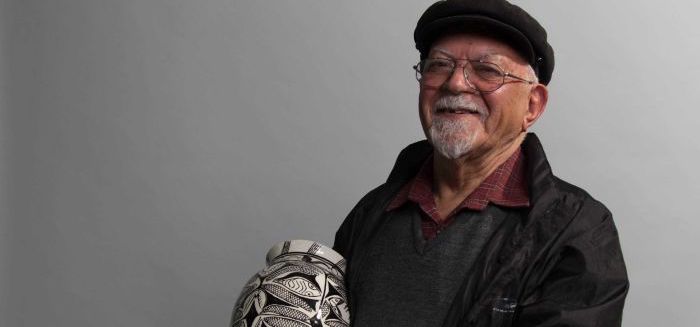
Uncle Vic Chapman is living proof of the Power of One.
The youngest of 15 children in 1944 he found a champion in local school teacher, Mr McKinnon, who recognised his academic promise. McKinnon suggested to Uncle Vic’s unschooled parents that he become an NSW State Bursar which would provide the funds for secondary education. At the age of 12, the first time away from parents and siblings he set off for Dubbo, at the time the nearest full high school from the QLD/NSW border.
On matriculation Uncle Vic trained as a Primary School teacher at Wagga Wagga Teachers’ College, later engaging in long-distance education at the University of New England. Release from the pressures of work and study came in the form of ceramics. Innate artistic ability, so useful in classroom practice, was a real asset. Retiring from teaching at the end of 1990 he enrolled in the Industrial Processes course at St George TAFE, learning mould making and slip casting and using underglazes for the first time. Coinciding with involvement in language revival of Yuwaalaraay (and Gamilaraay), the language he spoke as a youngster, he translated their stories to ceramic pieces and later to printmaking at COFA.
In 1997 Uncle Vic was invited to participate in one of two Wollongong City Council Reconciliation projects celebrating the 30th anniversary of the 1967 Referendum which guaranteed Indigenous people citizenship rights. Each project involved a person of Indigenous descent and a non-Indigenous person. Along with Alistair Cox of the Mt Gibb Pottery, Mittagong, they made the circular 3 metre diameter mosaic featuring the Yaroma, the hairy man, where the famous Moreton Bay fig tree once stood. The tree was of importance in the early days of white settlement to non-Indigenous people travelling from Sydney Town to work in the Illawarra and to Indigenous people as a Birthing Tree. Women came here to give birth, the welcome song was sung and the little one bathed in the creek nearby. The story of the Yaroma was well known and dissuaded those who might not have respect for this special place.
Uncle Vic’s retirement in 1990 from the NSW teaching service has been an extremely busy one, participating in many shows both as an artist (in Pallangjang 1, Pallangjang 2, In The Interest of Bennelong and Messages From the Fringe) and co-curator of Pallangjang 3.
His more recent exhibitions include Kaouwi Kaouwi in 2013 at the The Kahnawake Mohawk Territory in Montreal as part of the Montreal First Peoples Festival (curated by Tess Allas), Gamarada in 2014 at Burrinja Dandenong Ranges Community Cultural Centre (curated by JD Mittman and assisted by Tess Allas), Under Pressure in 2017/2018 at the Art Gallery of South Australia as part of the 2nd ‘Tarnanthi Festival’ (curated by Tess Allas, Michael Kempson and assisted by Honours student, Dennis Golding) and Ngurrambaa, 2018 Murray Art Museum Albury (curated by Michael Moran, Tess Allas and assisted by Honours student, Dennis Golding).

Image L-R: Doug Schofield from Cicada Press with Uncle Vic Chapman discussing Uncle Vic's The Fire Makers print. Uncle Vic Chapman, The Fire Makers, 2017, Etching and Aquatint. Cicada Press
His contribution to education and society, in general, was recognised with national awards of Public Service Medal and Centenary Medal. In 2015 UNSW instituted the Vic Chapman Equity Award which provides financial assistance to a student in his/her final year of Fine Arts.
Vic's life will soon be captured on film in an upcoming documentary commissioned by the New South Wales Teachers Federation and will feature interviews with Indigenous activists who have advocated for Aboriginal education over many decades. The documentary will be directed by Gillian Moody, Piers Grove, Xanon Murphy, and Paddy Gorman.
Fast forward to 2018 and Uncle Vic, as well as being a respected Yuwaalaraay Elder, is also Elder-in-Residence at the UNSW Art and Design. Here his talent in ceramics has been translated into a talent in printmaking. Here he still works alongside young people. He continues to demonstrate to students how one person can affect change in others. He has spent a lifetime being a champion of the young people he works with, a champion for preserving the language he was discouraged from speaking and a champion of his land and his people.
